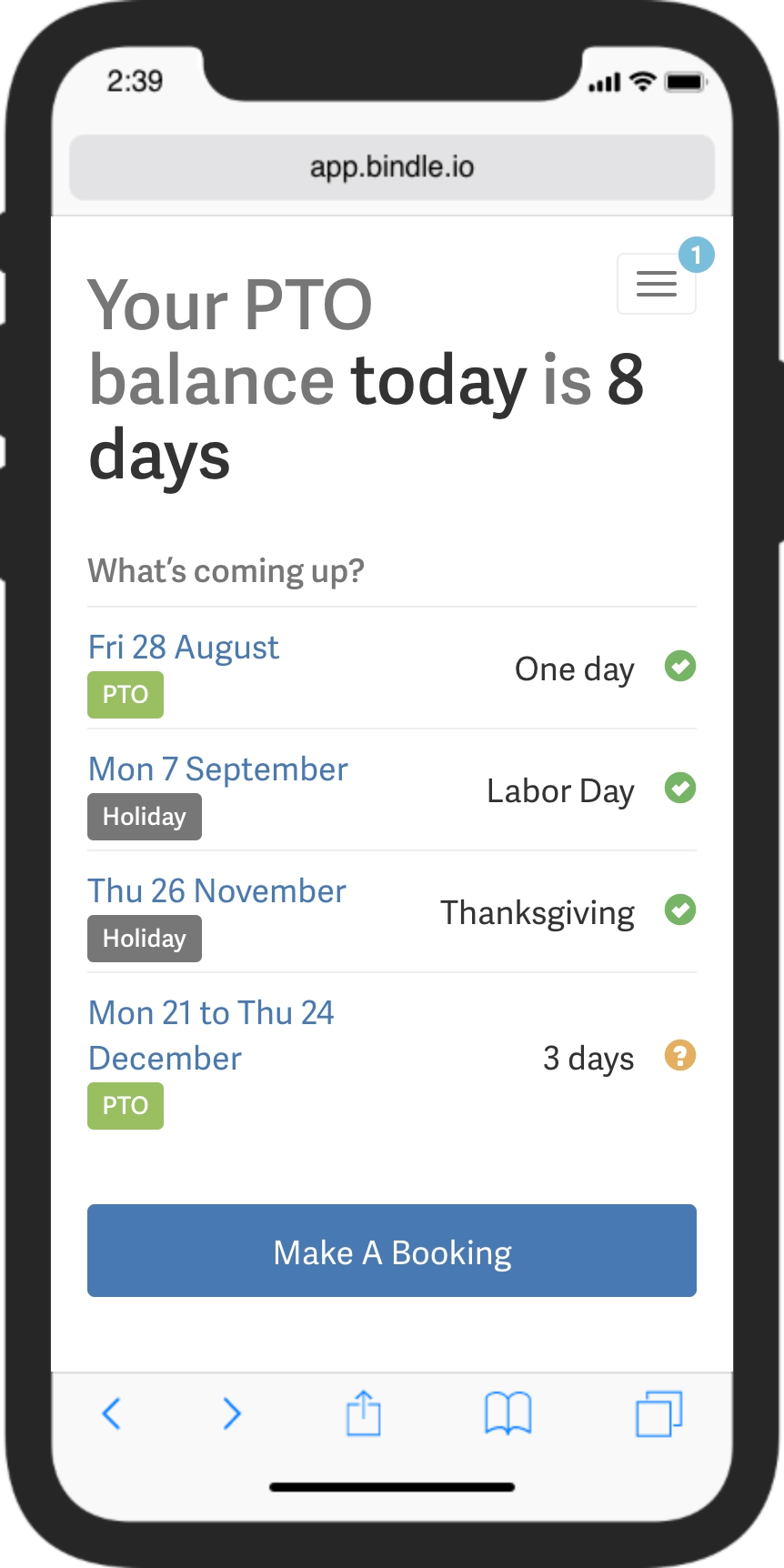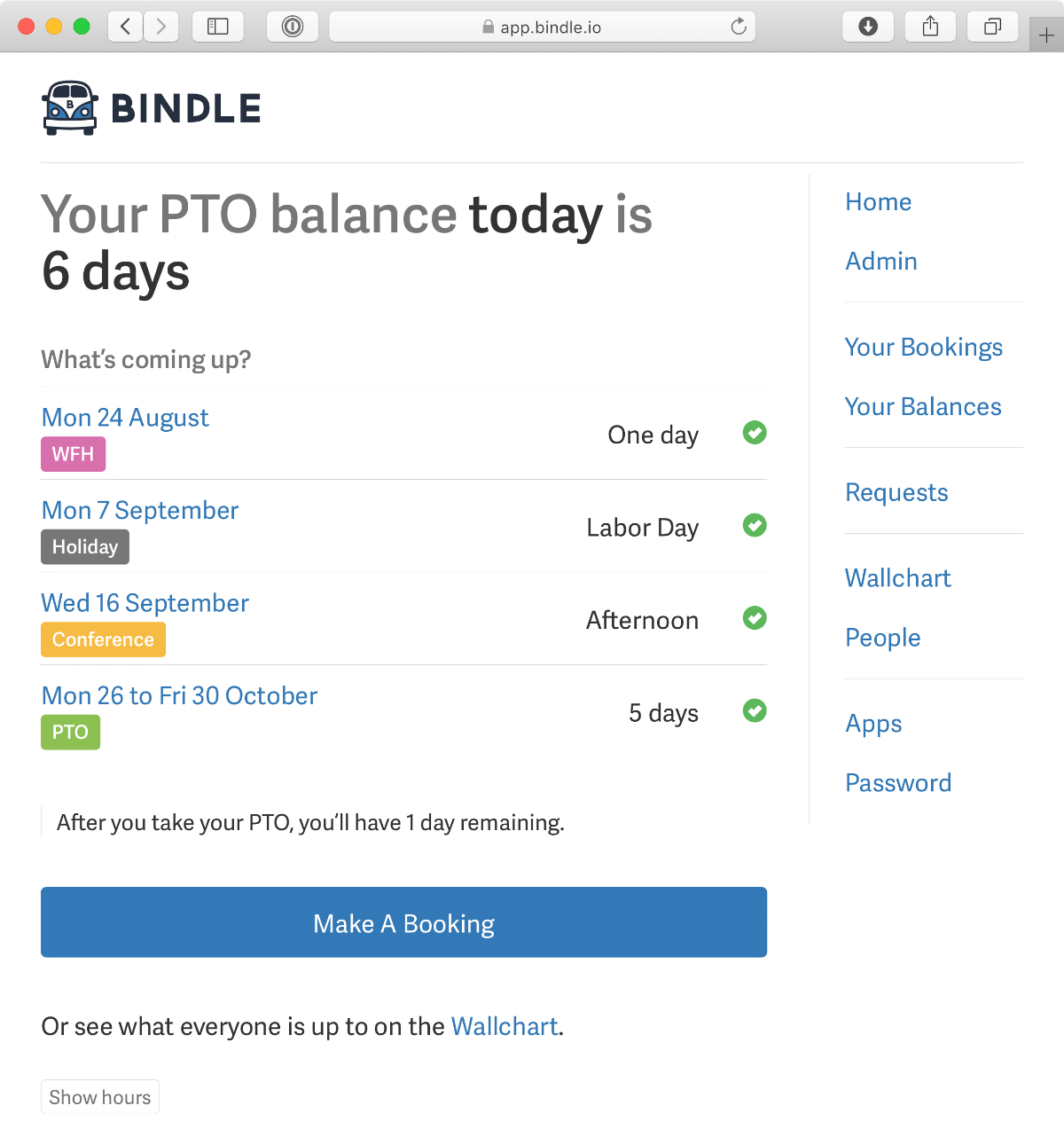This free guide was made by Bindle, Vacation & PTO Tracking Software for growing teams.
Give staff and managers direct access to request, view and manage their paid time-off.
30 days free.

At Bindle we’ve set up PTO tracking for hundreds of companies. We’ve learned a whole lot doing this, and put everything we’ve learned into this free guide to creating a Paid Time Off policy.
Our guide covers everything you need to know to set up a fair, clear PTO policy – what Paid Time Off actually means, how many days to give, different approaches to earning PTO, “use it or lose it” clauses, the best ways to manage Paid Time Off, and more.
The guide is completely free and available to read in full below. PDF version coming soon.
This free guide was made by Bindle, Vacation & PTO Tracking Software for growing teams.
Give staff and managers direct access to request, view and manage their paid time-off.

So what exactly is the PTO approach to staff time off?
Sometimes known as a “PTO bank”, the basic idea is that staff have a single allocation or “bank” of PTO, and that this allocation is used for all the different reasons that people need to take time off work. Whether the time off is for vacation, sickness, or some other reason, it all comes out of one allowance.
Why do this? From the company point of view, administration becomes simpler. From the employee’s perspective there is increased flexibility.
Although the PTO approach is flexible, a downside for staff is that a single allocation can make it harder to ensure that time off is available to cover illness. This could lead people to feel forced to work while sick, or to take blocks of unpaid time off.
The same issue exists for other things that can happen without much notice, like bereavement and jury duty. If you do adopt the PTO approach, it’s worth considering having an additional category of time off to cover unforeseen events.
Additional background information on PTO can be found on Wikipedia.
Before deciding on the PTO approach, it’s worth considering the two main alternatives.
Traditionally, staff have been given separate allocations of time off for vacation, sick leave, and personal days.
These traditional policies are still the most popular, particularly with larger companies. They are less flexible for staff, but have the advantage of not relying on staff budgeting time for unforeseen illness.
Unlimited time off policies are a relatively new thing. The big idea here is that if staff are responsible delivering their work in good time, why not also make them responsible for managing their time off?
Contrary to what you might expect, evidence suggests that staff in workplaces which offer unlimited time off actually take less time off. This is often attributed to company cultures which are strongly focussed on work.
Unlimited time off policies are popular with technology companies.
Once you’ve decided that PTO is the right approach for your company and staff, there are six main things to consider as you create your PTO policy.
The following sections cover each of these elements in turn, outlining the choices available to you and the factors that should influence your decision.
If you’re unsure of how much PTO to offer your staff, you might start by looking at some nation-wide averages.
For companies that award a fixed amount of PTO to all staff, the average allocation is 18 days per year (plus the 10 federal holidays).
However, around 90% of companies increase the amount of PTO they offer staff based on years of service. This is a great way to encourage employee retention.
On average, where companies increase PTO allowances as years of service increase, staff members receive the following number of days per year.
| Length of Service (years) | PTO allowance (days) |
|---|---|
| <1 | 13 |
| 1 | 15 |
| 2 | 15 |
| 3 | 16 |
| 4 | 17 |
| 5-9 | 20 |
| 10-19 | 24 |
| 20+ | 26 |
In arriving at your final decision, you should also consider factors like how competitive your industry and local region are for finding and retaining talent.
All figures from SHRM.
The two main approaches to earning PTO are to either grant your staff a lump sum once per year, or for staff to gradually accrue smaller amounts throughout the year.
Using this approach, once each year everyone in the company is granted their full allocation of PTO for the upcoming year.
Annual grants are generally considered the easiest way for managers and employees to think about time off balances: each person gets a number of days and over the course of the year they use them up.
A disadvantage of this method is that some states, like California and Massachusetts, consider PTO time that has been awarded to be have been earned. Therefore in the event of termination of employment, remaining PTO balances must be paid out. It’s worth reviewing the rules that are applicable in your state.
The second approach is for staff to accrue PTO gradually over the course of the year. Typically time off is accrued on either a daily or monthly basis.
With this approach, new staff need to work for a period of time to accrue sufficient PTO to to take time off. Some companies will allow staff to take time off in advance and for their PTO balance to go ‘into the red’.
Your leave policy should be clear about what you do and do not allow. Note that some states do not allow you to include a deduction for outstanding negative PTO balances from a staff member’s final pay check.
From an accounting perspective, a positive benefit of the accrual approach is that your business will gradually acquire the PTO liability throughout the year.
While balance calculations using the gradual accrual approach are more complicated, most tracking applications - including Bindle - make this straightforward.
We’ve helped hundreds of companies get their PTO systems up and running on Bindle.
We’d love to put our experience to work for you.
Interested? Send us a mail.

The next thing to consider when creating your PTO policy is when to start your PTO year.
The two main options are to either start the PTO year at the beginning of the calendar year for everyone in the company, or for each employee’s PTO year to start on the anniversary of their employment start date.
If you use the start of the calendar year, everyone’s balance is calculated on the same basis. It’s easy to see at a glance if anyone is building up a lot of unused PTO.
However, if you have a “use it or lose it” policy you may potentially end up with many people scrambling to use their PTO in December, which is a busy time for a lot of businesses.
Keep in mind that with this approach you’ll need to calculate pro-rata opening balances for new employees who start part way though the year.
For example if employees get 18 days PTO per year and a new employee starts on October 1, their pro-rata opening balance would be 3 / 12 x 18 = 4.5 days.
If you use anniversary of employees’ start dates as the start of the PTO year, everyone is on a different schedule and it’s harder to interpret people’s balances at a glance.
You don’t however have to worry about pro-rata balances for new employees in their first year.
Another advantage of this approach is that if you have a policy which gives progressively more time off to longer serving staff, the years of service tier employees fall into will correlate exactly with the accrual period, making it easier to calculate their PTO allowance.
Companies that take the traditional approach to staff time off commonly impose “qualification periods” on new employees. For example, employees may be required to work for 3 months before they begin to earn vacation.
Legislation covering paid sick leave however generally requires that new employees are eligible for sick leave from day one.
As PTO is intended to cover all types of time off including sick leave, if your company is subject to legislation that gives employees sick leave rights from the start of employment, you should not require a qualification period for PTO.
If you want to prevent people from building up large balances of unused PTO, three main options are available to you.
Pick a date (often 31 December) on which any unused leave is forfeited.
Pick a date (like above) but allow a limited number of days to be carried forward into the next year.
Decide on a maxium number of days that employees can accrue. Once this maximum is reached, no further leave can be accrued.
Although at first glance these policies don’t appear very favourable to staff, they can have the positive effect of encouraging people to actually use their allocated time off.
Be aware that some states, including California and Massachusetts, consider PTO to be equivalent to wages earned by the employee. They therefore do not recognize “use it or lose it” clauses. California does however allow employers to cap the amount of time off that staff can accrue.
Your policy should include either a maximum balance cap or a carry over limit. If your employees are granted PTO as an annual lump sum, both approaches have a very similar effect.
Where leave is granted as a daily accrual, maximum balance caps can be easier to understand than carry over limits.
In some states, paying out PTO balances upon termination of employment may be left to your discretion.
Other states like California require you to pay out PTO balances when an employee leaves.
We recommend that you check the relevant state governments’ websites and find out the rules that apply to you and your staff.
Note that for remote staff, the relevant state is the state in which the staff member is located.
Ideally, you should aim for a single policy for payout upon termination that is compliant in all states in which your employees are located.
A clear written PTO policy helps protect both your company and staff.
Many companies manage PTO by creating their own custom solution based on email and spreadsheets.
While this approach might seem like a way to save money, the true cost is hidden in the time it eats up, first to set things up and then to keep everything running smoothly.
Before you reach for Excel, we recommend you investigate dedicated tools for managing PTO, including Bindle.
This free guide is brought to you by Bindle – the way smart companies track PTO.
Bindle solves the four big problems you hit when you try to manage Paid Time Off using only email and spreadsheets.

This tool has been fantastic! The customer support I have received from the Bindle team is quick and very helpful.
We are very happy with Bindle PTO tracking! Huge time saver, we were able to get off a paper based, manual system. Employees love it.
Easy to set up and crucially does not need an instruction manual or training when I share with others in the team.